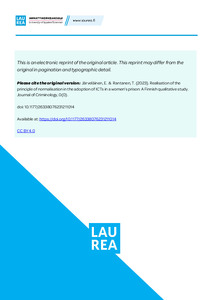Realisation of the principle of normalisation in the adoption of ICTs in a women's prison: A Finnish qualitative study
Järveläinen, Eeva; Rantanen, Teemu (2023)
Järveläinen, Eeva
Rantanen, Teemu
SAGE Publications
2023
Julkaisun pysyvä osoite on
https://urn.fi/URN:NBN:fi-fe20231218155308
https://urn.fi/URN:NBN:fi-fe20231218155308
Tiivistelmä
Digitalisation offers prisons versatile opportunities to promote the rehabilitation of incarcerated
people during their imprisonment, on their return to society, and in communicating with relatives
and service providers such as socialwelfare and health care services, housing services, and employment services. This study focuses on the Hämeenlinna prison, which is Finland’s first closed
women’s prison using personal in-cell laptops for each incarcerated person. We ask (1) how is
the principle of normalisation realised in the adoption of information and communication technologies
(ICTs) in a women’s prison and (2) how do cultural factors hinder the adoption of ICTs in prison. Research material was collected through ethnographic fieldwork and research interviews (22 prison employees and 15 incarcerated women). According to the results, the use of ICTs diversified and enhanced internal communication in the prison and offered a new tool for interacting in prison.The prison offered a limited opportunity for video-mediatedmotherhood, and efforts were made to respond to women’s multi-problematic service needs in prison, and through utilising various digital services. However, the study shows that the realisation of the principle of normalisation in the adoption of ICT in a women’s prison poses many challenges. Furthermore, security-oriented thinking and passive resistance appeared as key cultural factors that slow down the adoption of ICTs and new practices. As a conclusion, it can be stated that the adoption of ICTs and the construction of a new prison culture that utilises technology is a long-termprocess that requires a change in practices, culture and policies that emphasise security.
people during their imprisonment, on their return to society, and in communicating with relatives
and service providers such as socialwelfare and health care services, housing services, and employment services. This study focuses on the Hämeenlinna prison, which is Finland’s first closed
women’s prison using personal in-cell laptops for each incarcerated person. We ask (1) how is
the principle of normalisation realised in the adoption of information and communication technologies
(ICTs) in a women’s prison and (2) how do cultural factors hinder the adoption of ICTs in prison. Research material was collected through ethnographic fieldwork and research interviews (22 prison employees and 15 incarcerated women). According to the results, the use of ICTs diversified and enhanced internal communication in the prison and offered a new tool for interacting in prison.The prison offered a limited opportunity for video-mediatedmotherhood, and efforts were made to respond to women’s multi-problematic service needs in prison, and through utilising various digital services. However, the study shows that the realisation of the principle of normalisation in the adoption of ICT in a women’s prison poses many challenges. Furthermore, security-oriented thinking and passive resistance appeared as key cultural factors that slow down the adoption of ICTs and new practices. As a conclusion, it can be stated that the adoption of ICTs and the construction of a new prison culture that utilises technology is a long-termprocess that requires a change in practices, culture and policies that emphasise security.
